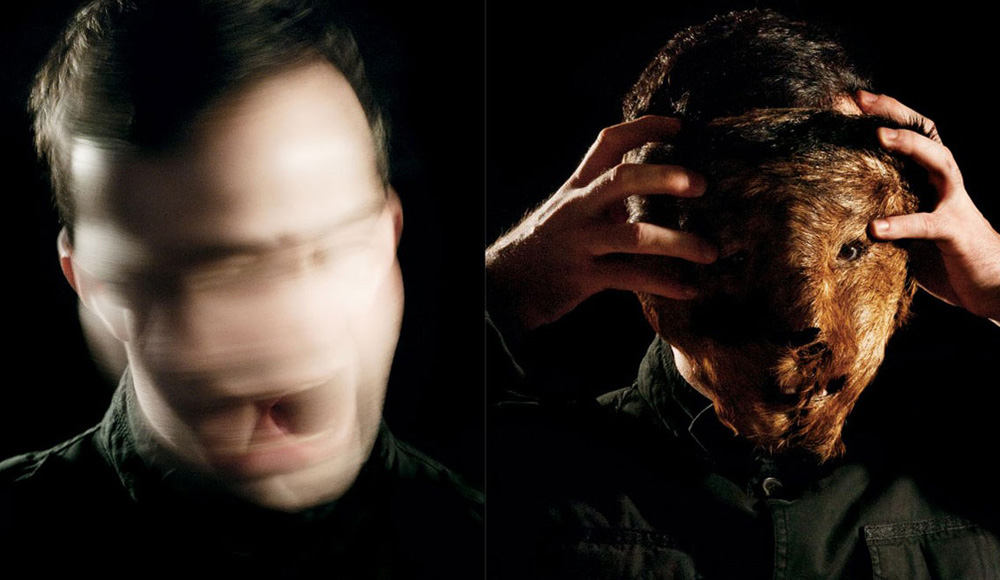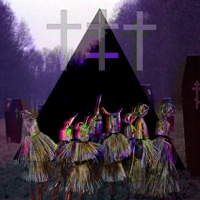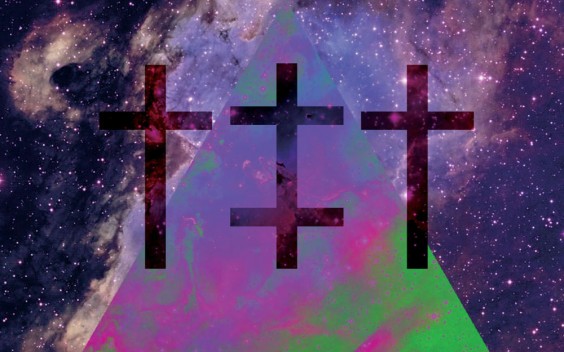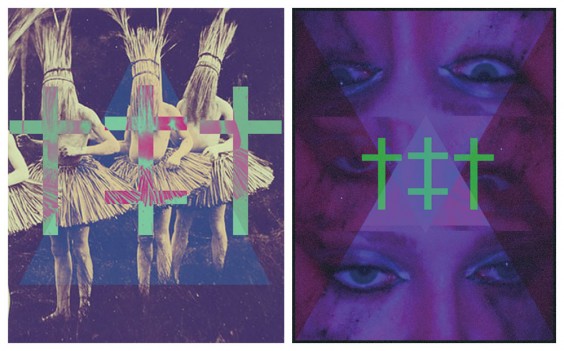This story first appeared in Chromatic: The Crossroads of Color and Music. Order your copy today.
†‡†: “gOth bb”
[audio:https://alarm-magazine.com/wp-content/uploads/2010/10/Ritualz_Goth_BB.mp3|titles=†‡† (Ritualz): “Goth BB”]Behind the dark electronica of †‡† (vocalized and alternately written as Ritualz) stands an anonymous, soft-spoken man. The latter is confirmed in fragmented bits over the phone, before technological limitations force the conversation to Google Chat. Once online, he explains that he’d prefer to keep his regular location to himself, though he divulges that he’s staying with family in Mexico City and has a date to perform in Monterrey, Mexico the following week. (San Marino, the location listed on his MySpace profile, is a red herring.)
An instant-message interview is very fitting; nearly everything about Ritualz’ short music career has happened on the Internet. Two days after making a MySpace profile showcasing a handful of gloomy trip-hop tracks under his nom de guerre, he signed to Houston-based micro-label Disaro. Run by Robert Disaro, the Disaro label is a standard bearer for a nascent electronic sub-genre that most are calling “witch house,” and Ritualz’ compelling mix of drone, synth hop, and industrial is a perfect fit.
The musical personality of Ritualz discovered itself online too. The man behind the moniker had worked unsuccessfully on a few electronic tracks prior to beginning Ritualz, and he compares those early attempts to “EBM kids trying to play The Knife or M83 songs” or “Fuck Buttons remixing ’90s dance hits.” He wanted a darker sound and found it when he came across witch-house brethren Salem and oOoOO while browsing The Fader and a file-sharing site, respectively. Their music introduced him to the basic tenets of the sub-genre and helped him find his own sound. “They brought in stuff from other genres,” he says. “I listen to hip hop and pop, but I never thought of bringing that into my music to make it darker. A dark synth line sounds darker with a hip-hop beat than a four-on-the-floor one. Reverb always helps.”
Warping divergent dance styles into a moody whole sets witch house apart from similar genres such as industrial. The music has been called both witch house and haunted house, but artists like Ritualz, Salem, and oOoOO seldom rely on house tempos. Some call the style drag, which is apt because it relies on attenuating and distorting samples and beats beyond recognition. In hip-hop terminology, this category of music is called “chopped and screwed,” meaning that witch house has roots in Houston hip-hop dating back to the 1980s and ’90s.
If Ritualz is an acolyte in this scene, he is a precocious one, with a talent for reaching into genres and drawing out their shadow selves. One of his songs (“>>>>∆<<<<”) employs samples of Diana Ross’ spoken intro to “Ain’t No Mountain High Enough” and HEALTH’s “USA Boys.” Components from both ends of that musical spectrum ride a dozing hip-hop beat, built under foreboding synth lines and wailing effects. The mixture is engaging despite Ritualz’ small sample size; he had just a handful of tracks and remixes online as of the summer of 2010, making his early publicity that much more remarkable.
Though he garnered attention by remixing label-mates Mater Suspiria Vision and Party Trash as well as solo artist Pink Priest, Ritualz didn’t release his debut EP, distributed on CD-R by Disaro, until late 2010. Befitting the Internet age, he did all this without meeting a single fellow musician or anyone connected to his label in person. For Ritualz, an online music scene is a logical result of his generation’s bond with the Web. “We were all growing up as the Internet got bigger during the mid-to-late-’90s, so a lot of the culture we’ve been in touch with comes from it,” he says. “Having access to stuff from around the world takes that ‘growing up in [blank]’ away from you, so you have a wider outlook on things. So now someone from France can relate a lot more with someone from Florida than they could’ve 20–30 years ago.” In fact, an artist might have more in common with a geographically scattered group of artists than anyone nearby, making an online scene both possible and necessary.
The artists associated with witch house seem to relish the anonymity of the Web while making full use of its multimedia possibilities. Names like †‡† are challenging to find via search engine, making the groups seem hidden even on the Internet. A search using the terms “salem” and “witch house” together brings results for tourist attractions in Salem, Massachusetts. The artists offer up few recognizable pictures of themselves, so music videos and faux-esoteric logos can be all that a fan has at first.
Heavily manipulating eerie film clips is another hallmark of witch-house songs and videos, and Ritualz says that his work is inspired by an abundance of visual media. One of his early tracks, “gOth bb,” samples demonic dialog from The Exorcism of Emily Rose, and he cites weird and disturbing films as one of his strongest visual touchstones, especially the work of David Lynch and Lars von Trier. He names von Trier’s nightmarish Antichrist as a major influence on the song “INITIATION,” noting that he hoped to recreate the sense of desolation that he felt from watching the film.
In February of 2011, Ritualz released a second EP, entitled Ghetto Ass Witch. The cover, fashioned with the same neon-splattered, pseudo-3-D aesthetic of the first record, sports a bikini-clad Lindsey Lohan emitting a bright green glow. Positioned directly behind her, and mostly obscured, is an image of Jesus Christ surrounded by expectant onlookers. On one hand, it’s the sort of high-art / low-art commentary that one would expect from an enigmatic Internet artist in the early 21st Century. On the other, it seems like an obvious commentary on modern celebrity worship, with the train-wreck actress front and center.
Ghetto Ass Witch’s opening track, “Ritualz,” begins with a low buzz, heavily cloaked in reverb, before blowing wide open with an imposing wall of doom that’s reminiscent of Hans Zimmer’s suffocating work on Inception. Vocals are present throughout the album, but after being run through multiple effects, the various growls and spoken-word passages become largely indecipherable. It’s a paradoxical sound. Pulsing dance beats recall the flashing-light euphoria of a traditional club atmosphere, but sinister synth and horror-score chord progressions threaten to dim the club’s lights entirely.
Though the immaterial online world feels like the most natural habitat for such ethereal and murky sounds, the artists do occasionally appear in the flesh. “Some bands play shows fairly often,” Ritualz says. “[Robert] Disaro DJs too. I see Modern Witch and White Ring flyers online all the time. [The scene is] there and growing.”
Ritualz’ own live performances involve a laptop, a MIDI controller, effect pedals, a mixer, and mics, and he usually throws in some improvisational noise and vocals. He books his shows himself, some of them in people’s houses; sometimes people dance, he notes, but sometimes they just watch and listen. Though he doesn’t do anything to conceal his identity when he performs, he doesn’t play all that often either. He admits, however, that his days of obscurity are numbered. “I guess once I start playing live more, that will be over,” he concedes. Still, relatively few people can say what the creator of †‡† looks like. And anyone who can is probably more interested in hearing his next remix.






